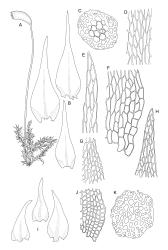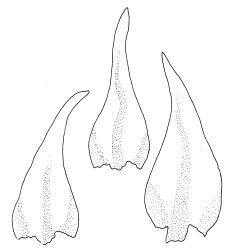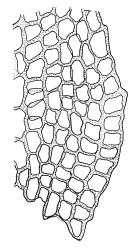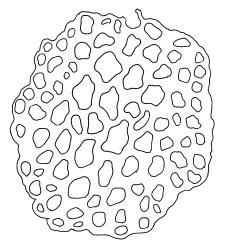- ≡ Leskea varia Hedw., Sp. Musc. Frond. 216 (1801)
- ≡ Hygroamblystegium varium (Hedw.) Mönk., Hedwigia 50: 275 (1911)
- ≡ Orthotheciella varia (Hedw.) Ochyra, Moss Fl. King George Island Antarctica 224 (1998)
Plants minute and delicate, yellow- to brown-green. Stems short (c. 5 mm) to elongate (to 50 mm or more), densely beset with smooth red-brown rhizoids, in cross-section with 3–4 layers of very thick-walled and pigmented outer cells grading into thinner-walled internal cells and a small central strand. Stem leaves slightly secund, ovate-lanceolate, tapered to a short and acute acumen, nearly flat, plane and very weakly serrulate at margins, (0.3–)0.9–1.0 × 0.3 mm; mid laminal cells rhomboid to oblong (mixed together), firm-walled, not porose, mostly 12–15(–21) × 6–7 µm and 2–3:1; alar cells subquadrate, firm-walled, and often ± yellow pigmented, forming a large but ill-defined group extending 12 cells or more up the margin and half or more the distance to the costa. Costa stout, c. 40 µm wide, ± flexuose, failing near the base of the acumen or occasionally shorter. Branches mostly c. 5 mm long. Branch leaves smaller, (0.3–)0.55–0.7 × 0.15–0.2 mm, with mid laminal cells mostly 2–3:1 and alar cells usually extending ± to the costa base. Paraphyllia variably developed, sparse or lacking to abundant, uniseriate (or biseriate at base), 4–12 cells long and mostly 65–150 µm.
Perichaetial leaves lanceolate, c. 1 mm. Setae long and flexuose, c. 20–32 mm; capsules cylindric from a moderately defined neck, inclined and asymmetric, c. 1.8 mm; operculum apiculate from a conic base. Exostome as per genus; endostomal cilia segments paired (or sometimes in 3’s), nodose. Spores 15–18 µm, ± smooth.
Ochyra 1998, fig. 148 (as Orthotheciella varia); Crum & Anderson 1981, fig. 450; Smith 2004, fig. 252, 9–12.
This is a very small and nondescript species which is difficult to name with complete confidence unless paraphyllia can be located. It is probably the smallest pleurocarp in the N.Z. flora; in populations in which stems are poorly developed (e.g., AK 179791) few leaves exceed c. 0.4 mm. The relatively large group of quadrate alar cells facilitates recognition, as does occurrence primarily in calcareous localities. Fruiting material has been seen only from "Waimarino Swamp" and Mayor I.
The distinction between this species and depauperate populations of Cratoneuropsis relaxa growing in ± xeric and calcareous sites can be very difficult. In A. varium the leaves tend to be erect to erect-secund and narrower and firmer in appearance, while in depauperate C. relaxa the leaves (especially stem leaves) are ± wide-spreading to slightly squarrose, broader and more delicate in appearance.
Amblystegium varium could be confused with compact forms of Cratoneuron filicinum, which also grows in calcareous sites. The lack of stem leaf decurrencies, the compact subquadrate alar cells and the relatively weak differentiation between stem and branch leaves in A. varium aid in distinguishing the two. The filiform paraphyllia, if observable, also contrast with the foliose paraphyllia of C. filicinum.
NI: S Auckland (Meremere, "Waimarino" [Whangamarino?] Swamp, Amokura, Mayor I.); SI: Nelson (Punakaikī); Canterbury (Castle Hill).
Bipolar? Widespread in the northern hemisphere and recorded from southern South America and numerous other southern hemisphere localities by Ochyra (1998, as Orthotheciella v.). Scott & Stone (1976, p. 410) doubted the occurrence of this species in SE Australia. There is some question as to the precise provenance of fruiting material (J.K. Bartlett s.n., 21 Sept. 1979, AK 185859) from "Waimarino Swamp". Curatorial notes attached to the specimen in AK suggest that this is likely a citation error for the "Whangamarino Swamp" in S Auckland L.D. This collection is one of only two N.Z. fruiting specimens seen.
This is a poorly documented species occurring mostly on mesic or moist limestone and concrete. However, material from the "Waimarino Swamp" came from "soil on rotting willow". At Punakaikī Amblystegium varium occurs on shaded coastal limestone in the salt spray zone. Few data are available concerning associates; Campyliadelphus polygamous, Zygodon cf. hookeri, and the lichen Leptogium sp. have been noted in herbarium mixtures. Known mainly from low elevations, but occurring at c. 800 m a.s.l. at Castle Hill, Canterbury L.D.
Paraphyllia are variably developed in N.Z. material and agree well with Ochyra’s (1998) figures. In some collections they cannot be observed, while in others they are sparse but visible in microscope preparations of stripped stem leaves. The abundance of paraphyllia seems to vary between plants within single collections.









